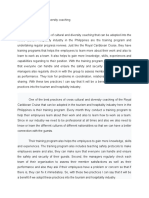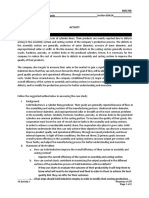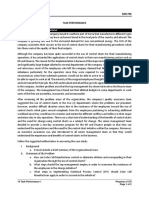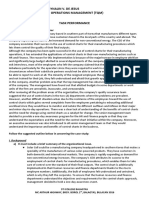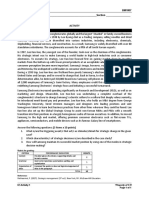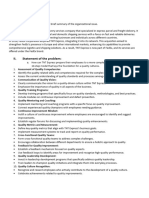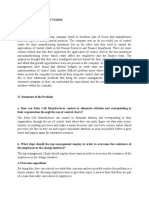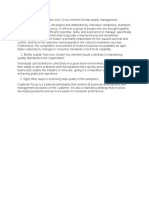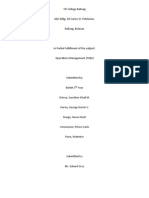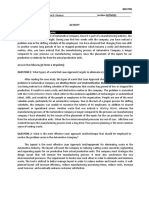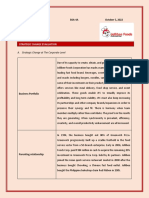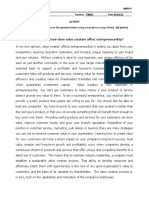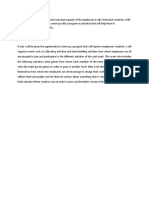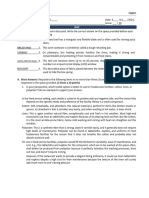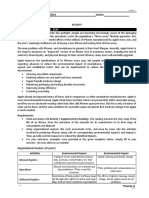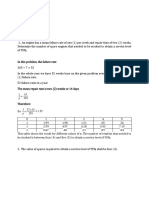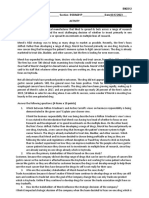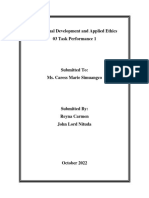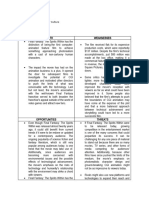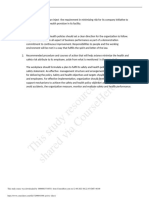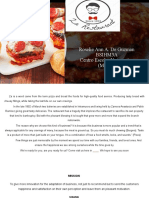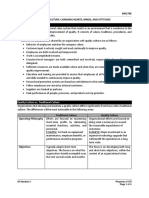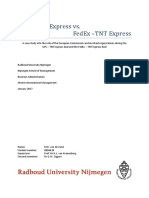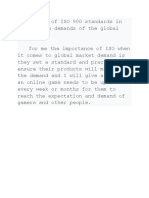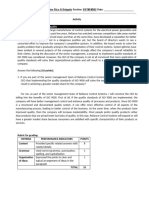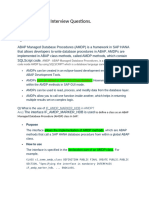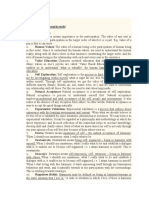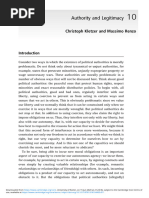11 Task Performance 3 PDF
Uploaded by
Cristopher Rico Delgado11 Task Performance 3 PDF
Uploaded by
Cristopher Rico DelgadoBM1708
TASK PERFORMANCE
TNT Express
TNT Express is a global express parcels company which offers time definite and day definite pickup and
delivery. It delivers an average of 4.4 million parcels, documents, and pieces of freight every week to over
200 countries worldwide. TNT’s origins date back after the Second World War in Australia in 1958.
In 1978, the growth of TNT really began to take off when it purchased County Express in the UK. TNT UK
continued to grow and offer new services and it became one of the most important contributing
businesses to the overall company performance. The culture of TNT was always described as
entrepreneurial with an emphasis on speed of action. This was further developed by the growth of the
company into a major player in the global express parcels market. The strength of the company was a
road and air network which connected the majority of the major economies. The different national
cultures and an entrepreneurial attitude created a successful but reactionary company.
Despite its milestone of success, TNT Express has experienced a major pitfall in 2004. With the
appointment of a new CEO, Marie Christine Lombard, her strategy was to change the company from a
traditional and entrepreneurial transport company to a global customer centric service based
organization. The advocacy of the new CEO will surely improve the overall performance of the company
in terms of logistics since it tries to adopt to the emerging needs of the market in a greater arena.
However, the result of the implemented change initiative does not reflect the goal. Major negative
feedback from customers bombard the management of the company. Some were saying that the changes
in the usual service do not serve its purpose because the shipment of items were relatively late or out of
deadlines. Others stated that TNT marketed itself as a global organization but variation in the way it
operated locally affected their experience. Most of the employees say that the change initiative affected
their performance since they are not prepared enough to face a more complex process in the shipment
of items. Another major reason for this problem was the number of disparate IT systems that tracks the
delivery and pick-up of items. This situation generated enormous maintenance costs and interface issues.
It was recognized that before TNT Express could implement a set of customer service or operational
systems that could be deployed globally, they needed a “common process.” The employees of the
company were relatively empowered and thus suggest that the company developed a graphical
representation of the different inflows and outflows of their logistical processes. Empowered employees
claim that after creating this representation, they will be able to match the existing IT systems to a more
complex system that would be efficient in monitoring the shipment and delivery of items. Therefore, the
CEO of the company decided that TNT, as a global organization, should map the existing processes and
agree to a global standard.
Follow the suggested outline below in answering the case study:
I. Background
a. It must include a brief summary of the organizational issue.
II. Statement of the Problem
a. How can TNT Express prepare their employees to a more complex work environment using
the 10-step model that lays the foundation for a quality culture? (Refer to Page 3 of 04
Handout 1.)
11 Task Performance 3 *Property of STI
Page 1 of 2
BM1708
b. What type of total quality tool/continuous improvement method should TNT Express
employ in order to create a graphical representation of the different inflows and outflows
of their logistical processes? (Refer to Pages 1-14 of 09 Handout 1.)
c. How can ISO 9000 contribute in the overall improvement of TNT Express’ organizational
performance? (Refer to Page 1 of 11 Handout 1.)
III. Areas of Consideration
a. It must include details and facts from the case that contribute to the organizational
problem of the company.
IV. Alternative Courses of Action
a. It must contain at least (2) two courses of action for every point stated in the statement of
the problem. It must also present the advantages and disadvantages of each course of
action in resolving the organizational problem.
V. Recommendation
a. It must present the best course of action among the presented alternatives in resolving
each organizational problem.
VI. Management Lessons Learned
a. It must discuss the takeaways from the case and the relevant things that the company
should do or not do in order to avoid the given organizational problems.
Rubric for grading:
CRITERIA PERFORMANCE INDICATORS POINTS SCORE
Wrote a concise summary of the case, the areas of
Executive Summary consideration presented, and the alternatives 20
proposed for the case
Organization of Adhered to the correct outline and content was
20
Ideas organized in a clear and logical manner
Provided all necessary research and analysis in
Analysis 30
support of the statement of the problem
Proposed a well-thought and well-researched solution
Recommendation 30
to the case study
TOTAL 100
Reference:
Oakland, J. (2014). Total quality management and operational excellence. New York: Routledge.
11 Task Performance 3 *Property of STI
Page 2 of 2
You might also like
- Car Care Plan (CCP) : Cristopher Rico A Delgado BSTM M502 Task Performance100% (1)Car Care Plan (CCP) : Cristopher Rico A Delgado BSTM M502 Task Performance6 pages
- CIQA PQ Template Protocol Lyophilization Process Sample Version100% (2)CIQA PQ Template Protocol Lyophilization Process Sample Version3 pages
- Case Study: Solid Industries: 10 Activity 1 Page 1 of 2100% (1)Case Study: Solid Industries: 10 Activity 1 Page 1 of 22 pages
- Case Study: Solar Cell Manufacturer: BM1708 Task Performance50% (2)Case Study: Solar Cell Manufacturer: BM1708 Task Performance2 pages
- Task Performance in The Entrepreneurial MindNo ratings yetTask Performance in The Entrepreneurial Mind1 page
- JOLLIBEE FOODS CORPORATION 03 Task Performance 1 Strategic Business AnalysisNo ratings yetJOLLIBEE FOODS CORPORATION 03 Task Performance 1 Strategic Business Analysis6 pages
- 05 Task Performance 1 - ARG (Reinald Zach Ramos)No ratings yet05 Task Performance 1 - ARG (Reinald Zach Ramos)2 pages
- The Life of An Iphone (Antonia, 2020) : Names Vless Butista Section Date ActivityNo ratings yetThe Life of An Iphone (Antonia, 2020) : Names Vless Butista Section Date Activity4 pages
- Activity: Case Study: A Challenge For QualityNo ratings yetActivity: Case Study: A Challenge For Quality1 page
- Procter & Gamble (P&G) (Danigelis, 2018) : Names: Giryl Jean S. Fernandez Section: Bsba-302B Date:03/04/22No ratings yetProcter & Gamble (P&G) (Danigelis, 2018) : Names: Giryl Jean S. Fernandez Section: Bsba-302B Date:03/04/222 pages
- Case Study: Building Quality and Operational Excellence in ABB50% (2)Case Study: Building Quality and Operational Excellence in ABB1 page
- Carmen Nituda Task Performance Professional Development and Applied EthicsNo ratings yetCarmen Nituda Task Performance Professional Development and Applied Ethics4 pages
- 01 Online Activity 1 - Understanding QualityNo ratings yet01 Online Activity 1 - Understanding Quality2 pages
- 01 Worksheet 1 (Online Version) SebongaNoelNo ratings yet01 Worksheet 1 (Online Version) SebongaNoel2 pages
- Roselie Ann A. de Guzman Bsihm3A Centro Escolar University - (Makati)No ratings yetRoselie Ann A. de Guzman Bsihm3A Centro Escolar University - (Makati)14 pages
- What Is Quality Culture?: BM1708 Quality Culture: Changing Hearts, Minds, and AttitudesNo ratings yetWhat Is Quality Culture?: BM1708 Quality Culture: Changing Hearts, Minds, and Attitudes4 pages
- 11 - Task - Performance - 1. 11 - Task - Performance - 2. 11 - Task - Performance - 3. 11 - Task - Performance - 4No ratings yet11 - Task - Performance - 1. 11 - Task - Performance - 2. 11 - Task - Performance - 3. 11 - Task - Performance - 415 pages
- Overview of Team Building and Teamwork: Student - Feedback@sti - EduNo ratings yetOverview of Team Building and Teamwork: Student - Feedback@sti - Edu3 pages
- Requirements For Implementation: Student - Feedback@sti - EduNo ratings yetRequirements For Implementation: Student - Feedback@sti - Edu4 pages
- De Guzman - Roselie Ann - 2018-20217 - Scholarship Award Form PDFNo ratings yetDe Guzman - Roselie Ann - 2018-20217 - Scholarship Award Form PDF2 pages
- The ISO 9000: The International Standard For Quality Management SystemsNo ratings yetThe ISO 9000: The International Standard For Quality Management Systems4 pages
- Cristopher Rico A Delgado BSTM M502: TNT Express100% (1)Cristopher Rico A Delgado BSTM M502: TNT Express5 pages
- Cristopher Rico Antaran Delgado: Personal ProfileNo ratings yetCristopher Rico Antaran Delgado: Personal Profile4 pages
- Centro Escolar University Scholarship Award Form: New RenewalNo ratings yetCentro Escolar University Scholarship Award Form: New Renewal2 pages
- Importance of ISO 900 Standards in Meeting The Demands of The Global MarketNo ratings yetImportance of ISO 900 Standards in Meeting The Demands of The Global Market1 page
- Cristopher Rico A Delgado BSTM M502: Stmicroelectronics100% (1)Cristopher Rico A Delgado BSTM M502: Stmicroelectronics5 pages
- Case Study: A Challenge For Quality: Activity100% (2)Case Study: A Challenge For Quality: Activity2 pages
- Adopting Quality Management For Business SuccessNo ratings yetAdopting Quality Management For Business Success14 pages
- Lloyd's Register Group: Cristopher Rico A Delgado BSTM M502 Task Performance100% (1)Lloyd's Register Group: Cristopher Rico A Delgado BSTM M502 Task Performance5 pages
- Introduction and Meaning of Globalization PDFNo ratings yetIntroduction and Meaning of Globalization PDF66 pages
- Vision 2030: "Caring For The Filipino and The World"No ratings yetVision 2030: "Caring For The Filipino and The World"7 pages
- Experiment 6 HPLC Determination of Ascorbic Acid in WineNo ratings yetExperiment 6 HPLC Determination of Ascorbic Acid in Wine5 pages
- 11 We'Ll Bite Your Tail, Geronimo by Stilton, GeronimoNo ratings yet11 We'Ll Bite Your Tail, Geronimo by Stilton, Geronimo133 pages
- Image Compression Using Resilient-Propagation Neural NetworkNo ratings yetImage Compression Using Resilient-Propagation Neural Network5 pages
- prepare-for-ielts-general-training-volume-1_reading-practice-test-2-v9-5913720No ratings yetprepare-for-ielts-general-training-volume-1_reading-practice-test-2-v9-591372031 pages
- Course Syllabus: University of San CarlosNo ratings yetCourse Syllabus: University of San Carlos4 pages
- Schedule For Summer Special Reappear (First Year Engineering)No ratings yetSchedule For Summer Special Reappear (First Year Engineering)6 pages
- Authority and Legitimacy: Christoph Kletzer and Massimo RenzoNo ratings yetAuthority and Legitimacy: Christoph Kletzer and Massimo Renzo17 pages
- Sikaceram®-200 Ta Tilefix: Product Data SheetNo ratings yetSikaceram®-200 Ta Tilefix: Product Data Sheet3 pages


